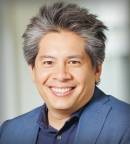Late relapse of diffuse large B-cell lymphoma (DLBCL) may represent a new lymphoma arising from a common precursor cell that is essentially chemotherapy-naive. Treatment with curative intent using a second-line regimen like R-CHOP (rituximab cyclophosphamide, doxorubicin, prednisone, and vincristine) resulted in a median time to disease progression of 45 months, with 55% of patients remaining progression-free at 2 years, researchers from the BC Cancer in Vancouver, British Columbia, found.1

Jean-Nicolas Champagne, MD
In the study reported at the 2024 American Society of Hematology (ASH) Annual Meeting & Exposition,1 65 patients were followed for a median of 31 months. The response rate to second-line R-CHOP–like therapy was 72%. Median overall survival was 39 months, and median disease-free survival was 62 months. Approximately one-third of the patients who died during this study did so for reasons unrelated to the lymphoma or its treatment, according to Jean-Nicolas Champagne, MD, who said this type of treatment “may allow some patients to avoid the needless toxicity of more intensive therapeutic options.”
Why Retreat With R-CHOP–Like Therapy?
“Most patients with DLBCL who experience relapsed or refractory disease following R-CHOP will do so within 24 months of diagnosis, but relapses beyond 2 years can occur and are typically associated with better outcomes,” Dr. Champagne stated. “It has been shown in late relapse biopsies that these tumors share very few mutations with the original diagnosis, but despite the time gap between the two events, they tend to maintain the same cell of origin. Therefore, late relapse may represent a new lymphoma arising from a common precursor cell, and this disease is thought to be chemotherapy-naive.”
Salvage therapy plus stem cell transplantation is the recommended second-line therapy here, but many patients are unsuitable for such treatment. R-CHOP and R-CEOP (with etoposide substituted for doxorubicin) are treatment options. R-CEOP can be curative in the front-line setting for patients with anthracycline contraindications or frailty. In British Columbia, patients with late relapse often receive R-CHOP or R-CEOP for six cycles or several cycles of R-CHOP to reach a lifetime anthracycline maximum followed by R-CEOP, Dr. Champagne explained.
Study Details
The investigators used the BC Cancer Centre for Lymphoid Cancer Database and the BC Cancer Pharmacy Database to retrospectively identify patients meeting these criteria: confirmed de novo DLBCL, receipt of front-line curative-intent R-CHOP–like therapy, relapse beyond 24 months, and treatment with second-line curative-intent R-CHOP–like therapy. The study’s primary outcome was time to disease progression from the time of the second DLBCL diagnosis.
Researchers found 65 patients with advanced-stage disease who had undergone curative-intent second-line R-CHOP–like therapy, which represented 25% of the 262 patients identified with late-relapse DLBCL in the database. The second-line treatments were primarily platinum-based with or without transplant (44%) and an R-CHOP–like regimen (25%). Some patients received polatuzumab vedotin-piiq plus bendamustine/rituximab (BR), radiation therapy, palliative-intent chemotherapy, and best supportive care. Median patient age was 77, and the median time to relapse was 7.4 years.
KEY POINTS
- Late-relapse diffuse large B-cell lymphoma may represent a new lymphoma arising from a common precursor cell that may be chemotherapy-naïve.
- Treatment with curative intent using a regimen like R-CHOP (rituximab cyclophosphamide, doxorubicin, prednisone, and vincristine) resulted in a median time to disease progression of 45 months; 55% of patients were progression-free at 2 years, according to a study from BC Cancer.
The cell of origin was mostly germinal center B subtype. Cell of origin at late relapse was highly concordant (94%) with the diagnostic biopsy. Dual rearrangement of MYC and BCL2 was observed in 9% of patients tested. The median number of cycles was five (range, 1–6). Four patients were treated with a limited-stage approach; six of seven patients intended for transplant received one after responding to R-CHOP–like therapy. A total of 26% of patients starting R-CHOP were switched to R-CEOP; the others were treated upfront with R-CEOP.
Further Findings
“We looked at time to progression according to the timing of relapse, and we observed that patients who experienced a relapse between 2 and 5 years from their initial diagnosis actually had poor outcomes,” Dr. Champagne said. For that cohort, the median time to disease progression was less than 7 months, and the 24-month time to disease progression was 9%. Conversely, for patients relapsing more than 5 years from diagnosis, these numbers were 86 months and 68%, respectively. No significant differences were observed according to the cell of origin at the time of relapse. “More data will be needed to better delineate outcomes according to the timing of late relapse,” Dr. Champagne concluded.
Expert Point of View
The ASCO Post asked Frederick Lansigan, MD, lymphoma specialist and Program Director of the Hematology and Oncology Fellowship Program at Dartmouth Hitchcock Medical Center and Geisel School of Medicine at Dartmouth, for his thoughts on the BC Cancer study. The study, which drew from a large database, found that for patients with late relapse of diffuse large B-cell lymphoma (DLBCL), retreatment with a regimen like R-CHOP (rituximab cyclophosphamide, doxorubicin, prednisone, and vincristine) is a solid treatment option.

Frederick Lansigan, MD
“For patients relapsing beyond 2 years, an R-CHOP–like regimen has a fairly decent response rate and progression-free survival, and it’s even more effective for patients who relapse beyond 5 years,” Dr. Lansigan noted. “This is a very interesting approach for late DLBCL relapse, because many physicians don’t think about reusing R-CHOP, assuming there must be some treatment resistance.”
One impediment or drawback to using R-CHOP, he added, is that patients often reach the “ceiling dose” for the anthracycline, making this approach “more cumbersome.” In the study, such patients were switched to R-CEOP, which substitutes etoposide for doxorubicin.
According to Dr. Lansigan, it is still likely that physicians will opt to treat late relapse with polatuzumab vedotin-piiq plus bendamustine/rituximab or platinum-based chemotherapy, but R-CHOP proves itself to be a viable option. Of note, this approach is especially attractive in low-resource settings, where issues of cost and drug availability are important, noted Dr. Langisan, who has an interest in health disparities and has been active in global public health. “The data shed light on the possibility of reusing R-CHOP, especially for patients relapsing after 5 years,” he said.
DISCLOSURE: Dr. Champagne has received honoraria from BeiGene. Dr. Lansigan reported no conflicts of interest.
REFERENCE
- Champagne JN, Villa D, Gerrie AS, et al: Retreatment with R-CHOP-like therapy in patients with late relapse of diffuse large B-cell lymphoma. 2024 ASH Annual Meeting & Exposition. Abstract 109. Presented December 7, 2024.

